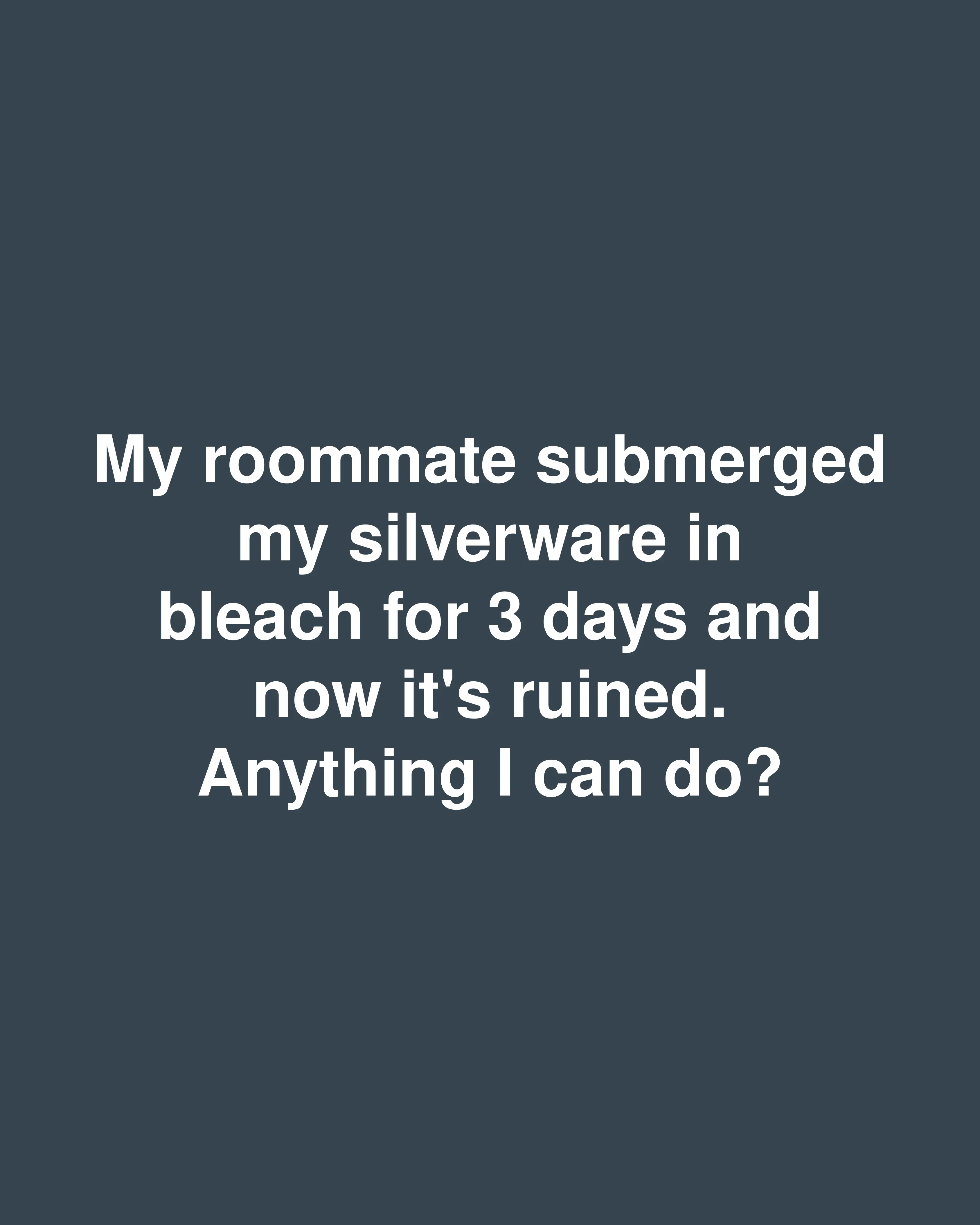Want to save this recipe?
Enter your email below and we’ll send the recipe straight to your inbox!
Silverware Disaster: What to Do When Bleach Ruins Your Utensils
Have you ever faced a kitchen crisis that left you completely baffled? Imagine discovering your silverware has been soaking in bleach for three entire days! Whether it happened due to a roommate misunderstanding or an unfortunate accident, this situation can feel both frustrating and overwhelming. The good news? You have options, and this guide will walk you through exactly what to do when bleach threatens to ruin your precious utensils.
Understanding the Bleach Damage Crisis
Bleach might be a cleaning superstar for many household tasks, but it’s absolutely devastating for metals. When silverware—whether it’s genuine silver, stainless steel, or silver-plated—sits in bleach for extended periods, a destructive chemical reaction occurs. The powerful oxidizing agents in bleach attack the metal surface, potentially causing:
- Dark discoloration or spotting
- Surface pitting and etching
- Weakening of the metal structure
- Complete removal of any protective coating
- Permanent damage to ornate patterns or designs
The severity depends on several factors: the concentration of the bleach solution, the exact metal composition of your silverware, and of course, the duration of exposure—with three days being particularly concerning.
Emergency Rescue Protocol for Bleach-Damaged Silverware
Step 1: Immediate Removal and Neutralization
First things first—get that silverware out of the bleach immediately! Rinse each piece thoroughly under cool running water for at least 30 seconds per utensil. This stops the ongoing chemical reaction and washes away any remaining bleach residue.
For extra protection, prepare a mild acid solution to neutralize any lingering bleach. Mix one tablespoon of white vinegar with one cup of water, and give each piece a quick dip, followed by another thorough rinse.
Step 2: Gentle Drying Technique
Pat each piece completely dry with a soft, lint-free cloth. Avoid abrasive materials that could further scratch damaged surfaces. Be meticulous about drying every crevice, as lingering moisture can exacerbate existing damage.
Step 3: Damage Assessment
Now comes the critical evaluation. In good lighting, carefully examine each piece of silverware for:
- Discoloration: Black or brownish spots indicate oxidation
- Texture changes: Run your finger along the surface to feel for pitting
- Structural integrity: Check for unusual flexibility or weakness
- Pattern degradation: Note any fading in decorative elements
Sort your silverware into categories: minimally damaged, moderately affected, and severely compromised. This triage will help you determine appropriate restoration approaches for each piece.
Restoration Options for Different Damage Levels
For Minimal Damage: DIY Polishing
If you’re dealing with light discoloration without significant pitting, a gentle polishing might do the trick:
- Apply a small amount of silver polish or stainless steel cleaner to a soft cloth
- Gently rub in circular motions, following the grain of the metal
- Rinse thoroughly and dry immediately
- Repeat if necessary, but avoid over-polishing which can wear down plating
For stainless steel items specifically, try making a paste with baking soda and water. This mild abrasive can help lift surface discoloration without causing further damage.
For Moderate Damage: Specialized Treatments
When facing more noticeable pitting or discoloration that simple polishing won’t fix:
- For genuine silver: Try an aluminum foil bath by lining a glass dish with aluminum foil, adding hot water and a tablespoon of baking soda, then submerging the silverware for up to 30 minutes
- For silver-plated items: Consider a specialized silver dip (following package instructions exactly)
- For stainless steel: A paste of cream of tartar and water applied for 10 minutes might help restore shine
Remember that these treatments may improve appearance but cannot reverse structural damage or deep pitting.
For Severe Damage: Professional Restoration
When silverware shows significant corrosion, deep pitting, or structural compromise, professional restoration may be your only option—especially for valuable or sentimental pieces:
- Contact professional silversmiths or metal restoration specialists
- Inquire with jewelry stores that offer silver restoration services
- Request cost estimates before proceeding, as professional restoration can be expensive
Preventing Future Silverware Disasters
Clear Communication with Roommates
After resolving the immediate crisis, have a calm, constructive conversation with your roommate. Instead of assigning blame, focus on creating a system that prevents future mishaps:
- Designate specific cleaning products for different household items
- Label cleaning supplies clearly with their appropriate uses
- Consider creating a simple household guide for shared cleaning responsibilities
- Establish protocols for handling each other’s personal items
Safe Cleaning Practices for Silverware
Make sure everyone in your household knows the proper way to clean silverware:
- Use mild dish soap and warm water for routine cleaning
- Avoid harsh chemicals like bleach, ammonia, and abrasive cleaners
- Dry promptly after washing to prevent water spots
- Store properly in a dry place, ideally in an anti-tarnish cloth or container
The Silver Lining: Alternative Solutions
If restoration isn’t feasible or cost-effective, consider these creative alternatives:
- Replacement options: Check if individual pieces from your set can be purchased separately
- Repurposing damaged pieces: Transform damaged silverware into unique jewelry, garden markers, or decorative hooks
- Mix and match appeal: Embrace an eclectic table setting with intentionally mismatched silverware
- Insurance claims: If the silverware was valuable, check if your renters or homeowners insurance might cover replacement costs
Quick Recap: Your Bleach Recovery Action Plan
- Remove silverware from bleach immediately
- Rinse thoroughly and neutralize with mild acid
- Dry completely with soft cloth
- Assess damage levels for each piece
- Apply appropriate restoration techniques based on damage severity
- Establish new household protocols to prevent future incidents
- Consider alternatives if restoration isn’t viable
Remember that while bleach exposure can be devastating for silverware, quick action and the right restoration approach can save many pieces from total ruin. The most important step is preventing future incidents through clear communication and proper cleaning knowledge.
Frequently Asked Questions
Can genuine silver ever fully recover from bleach damage?
While surface tarnish and light discoloration can often be restored, deep pitting and structural damage are usually permanent. The success of restoration depends greatly on how quickly you addressed the situation and the concentration of the bleach solution.
Is it safe to eat with silverware that was soaked in bleach?
Once thoroughly rinsed and cleaned, the silverware is generally safe to use. However, if there’s significant pitting or damage to the surface, these areas could potentially harbor bacteria, making replacement the safer option.
Should my roommate pay for the damaged silverware?
This depends on your relationship and the circumstances. An honest mistake calls for a different response than negligence. A reasonable approach might be sharing the cost of replacement or restoration, especially for valuable items.
Can I prevent tarnishing on my restored silver pieces?
Yes! Store your silverware in anti-tarnish cloth or containers, keep them in a low-humidity environment, and clean them regularly with appropriate silver care products to maintain their restored appearance.


